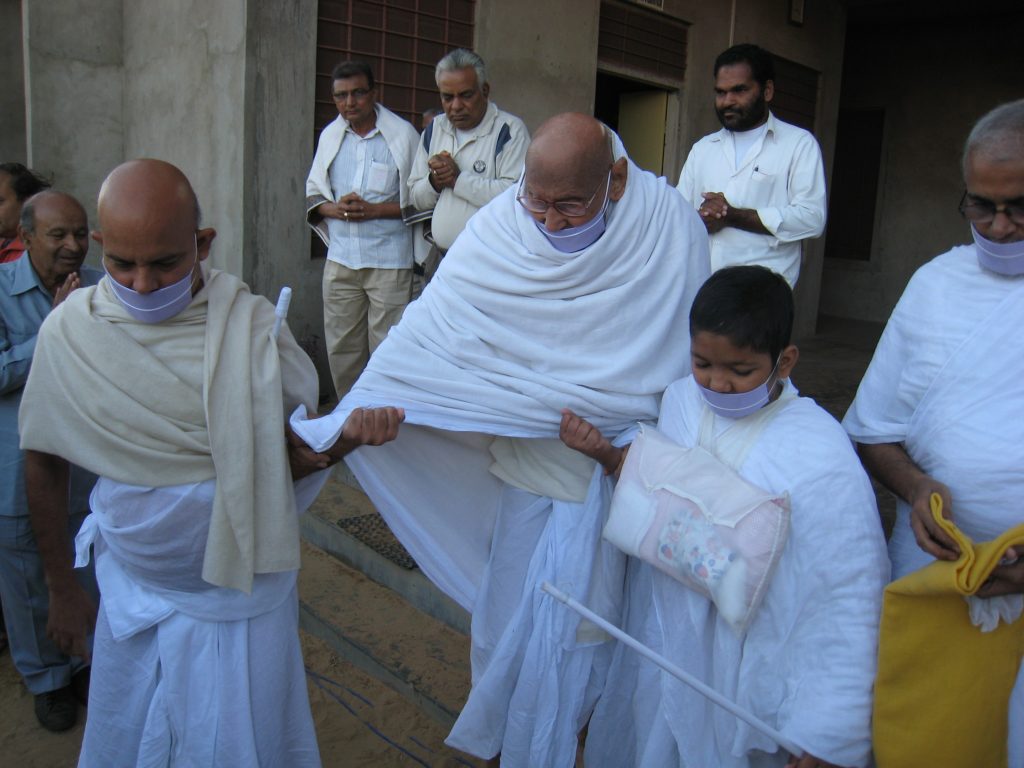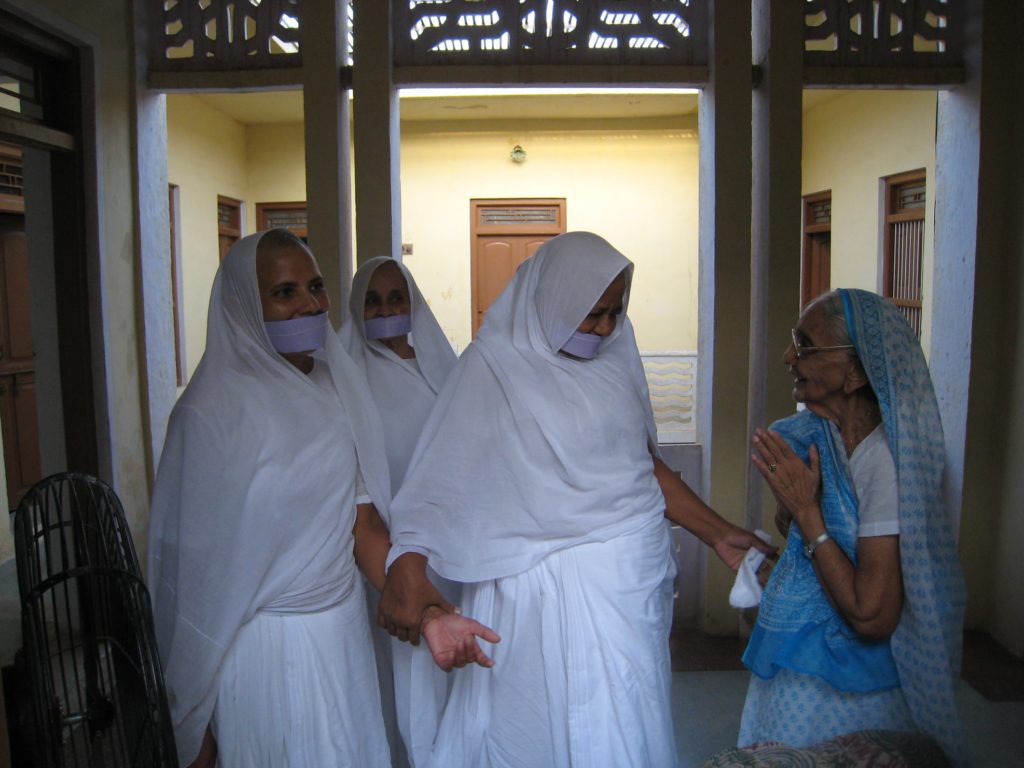
If somebody is a real symbol of non-violence, love, compassion, peace, harmony, oneness, then he is the perfect Jain. We can’t convert any Jains, but you can convert your habits, your mind.
Acharya Shri Sushil Kumar[i]
Your own truth frees you. Others’ truths bind you.
Ram Jain, 2021
‘Om Shanti, ॐ शान्तिः’ is an invocation for peace and is a fundamental aspect of Jainism, a religion predominantly practiced in the North-West of India. Practitioners devote their life to obtaining spiritual purity. Through a life philosophy rooted in ahimsa (non-violence to all creatures), they seek ‘enlightenment’.[ii] In Jainism, enlightenment refers to letting go of one’s ego and one’s attachment to material things. A practicing Jain possesses little material wealth,[iii] and aims instead for their soul to achieve moksha: the soul uniting with reality by freeing itself from the veil of ignorance in the material world.[iv] Janism is one of the three major and most ancient religions in India, alongside Hinduism and Buddhism. In Jainism, there is no god – only souls. Therefore, rather than praying to one holy God, Jains pray to and for the souls of the whole universe.
The word ‘Jain’ refers to one who conquers their inner feelings of hate, greed, and selfishness. Overcoming one’s desires and not being controlled by one’s senses is essential. Practicing Jains are amongst the least violent people in the world. They follow a strict vegetarian diet, and they do not eat root vegetables because that means killing the plant instead of just nibbling from it. Furthermore, they wear masks wherever they go in order to avoid inhaling flies and little molecules in the air. Jains must never do work that destroys life. To me, Jainism is one of the most peaceful philosophies of life, not only because it promotes a sense of inner peace but also because it promotes gentle, compassionate, peaceful interactions with the wider world.


Our senses are our friend when we control them, and our enemy when they control us.
Ram Jain, 2021
In the Netherlands, I was taught by Ram Jain, who was brought up practicing Jainism. I am in deep gratitude to him and all the other inspiring people who have sparked my interest to bring this narrative to the museum. Through their teachings, I learned that meditation is a key pillar in freeing the body and mind from suffering. Moving beyond oneself and reducing the suffering for others is the end. Ultimately, that means the liberation of the soul(s) in the world.
Before any yoga training, meditation practice, or philosophy class, we would chant ‘Om Shanti. ‘Om’ means God. However, as stated, there is no God in Jainism. Therefore, ‘om’ translates into a dedication to whom or whatever one perceives as divine. ‘Shanti’ means peace. Thus, ‘Om Shanti’ is an invocation for peace. The chanting would echo out in the room: Om, om, om, shanti, shanti, shanti. And then, our teachings would begin.
This way of visualising peace emphasises the individual, while also remaining mindful of the world we inhabit. To achieve peace, one must let go of one’s ego and let the mind unite with the natural world, where political, economic, cultural, and social factors are obsolete. Jainism’s strict spiritual way of life seeks a wholesome understanding of the universe wherein everything is connected through souls.[v] Every living being, stretching from a water molecule to a human being, possesses a soul. Ultimately, love for one’s own soul means love for all other souls and beings too. Yoga and meditation are important steps to master, to bring this perception of peace into one’s way of life. In sum, Jainism and yoga philosophy cherish different aspects of life, but the central focus is to practice non-violence and to invoke peace – both inner peace and peaceful interactions with the world.
What do you think?
- How does Jainism’s principle of non-violence align with your idea of peace?
- What impact might the connection between inner peace and enlightenment in Jainism have on how you view peace more broadly?
- Is peace always non-selfish? Should it be?
- What difference does it make to embody and vocalise peace through meditation and chanting, rather than just to think about peace?
- What influence do Jain ideas of peace have on how you view the opposite of peace (e.g. violence, or conflict, or inner strife)?
If you enjoyed this item in our museum…
You might also enjoy ‘Inner Peace‘, ‘Mindful Peace‘, ‘Make me a Channel of Your Peace‘, ‘Oseh Shalom‘ and items with the tag ‘Embodied Peace‘.
Otilia Meden, May 2022
[i] Acharya Shri Sushil Kumar was a Jain monk (1926-1994) who promoted non-violence, peace, and knowledge of the self for more than 50 years of his life. His goal was to unite the world with ahimsa (non-violence).
Quote from: https://jainismspecialproject.wordpress.com/2016/02/08/words-of-wisdom/.
[ii] For more information about Jainism:
https://www.youtube.com/watch?v=h_VA7mWWn58&t=2s
Wadhwani-Shah, Yashodhara. 1996. “SOME KEY CONCEPTS OF JAINISM : DISCUSSED AND CORRELATED.” Annals of the Bhandarkar Oriental Research Institute 77 (1): https://www.jstor.org/stable/41702168?seq=1
https://jainismspecialproject.wordpress.com/2016/02/10/7/
Titze, Kurt & Bruhn, Klaus. 1998. Jainism: A Pictorial Guide to the Religion of Non-Violence. Motilal Banarsidass Publishers. https://books.google.dk/books?id=loQkEIf8z5wC&printsec=frontcover&hl=da#v=onepage&q&f=false.
[iii] Every human has an ego. However, to achieve spiritual enlightenment, Jains must conquer their ego to practice self-love and peace. For example, read the story on page 9-11 in Jainism: A Pictorial Guide to the Religion of Non-Violence: https://books.google.dk/books?id=loQkEIf8z5wC&printsec=frontcover&hl=da#v=onepage&q&f=false.
[iv] Moksha refers to a place where the soul is liberated, emancipated, and free from death and rebirth. To attain Moksha, the soul must be enlightened. For more information, see: https://www.britannica.com/topic/moksha-Indian-religion.
[v] If you are interested, besides the above links, articles and books, I recommend you to visit: https://jainpedia.org/themes/principles/jain-beliefs/soul/.